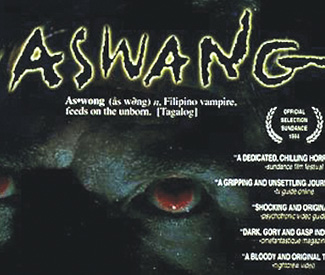TRASH A primary figure in Philippine folklore dating back centuries, the aswang is a monster that has taken many forms — shape shifting being one constant. But arguably the most prevalent, at least in pop culture today, is that of a vampiric “witch” who uses the guise of a seemingly harmless old woman to ingratiate herself wherever there are pregnant women or young families, with the goal of eventually making a snack of the newborn or not-quite-yet-born. They manage the latter selection by using an extremely long proboscis to suck the … oh, you don’t want to know. (Although surely that image will someday be used by the ever-more-hysterical anti-abortion forces.)
Yerba Buena Center for the Arts’ “New Filipino Cinema” series (see Film story) features a mockumentary about Lilia Cuntapay, a senior actor whose modicum of local fame has come from playing variations on these mythical creatures, notably in the never-ending Shake, Rattle & Roll horror movie franchise. But for all the aswang’s ongoing ubiquity in the Philippines — a popular costumed Aswang Festival was held for several years in provincial Capiz until the Catholic Church got it shut down as “devil worship” — it’s rarely surfaced in entertainment abroad. Of course other cultures have their own traditional ghouls to play with. But it’s hard to deny that the baby lifeforce-sucking hag is a concept rather low on international-export value
One major exception is among the great underappreciated U.S. indie horrors of the last 20 years: 1994’s Aswang, shot on 16mm in and around Milwaukee for a reported grand total of $70,000, was the first feature for young Midwesterners Wrye Martin and Barry Poltermann. Their screenplay, devised from a story idea by Philippines-raised friend Frank Anderson, was the heartwarming tale of a lass in conventional “trouble” who finds a savior who’ll do what’s best for both her and her unwanted baby. Or so she thinks.
Knocked up by an irresponsible mullet-head boyfriend, barely-legal Katrina (Tina Ona Paukstelis) refuses to abort, instead agreeing to an unusual advertised offer: she will carry the child to term, posing as the bride of Peter Null (James Spader-ish Norman Moses). The last male heir to an aristocratic émigré Filipino clan, he claims he and his actual wife cannot conceive, and must resort to this ruse to inherit the family fortune. In an uncomfortable meeting presided over by a hilariously bored lawyer (John Garekis), the parties meet and sign the necessary contractual documents.
Seven months later, now ready-to-pop Katrina and her “husband” reunite, driving from the city to Chez Null, a rambling, isolated rural property with an aura of going-to-seed grandeur. She’s introduced to regal matriarch Olive (Flora Coker), given a creepy once-over by Tagalog-only-speaking housekeeper Cupid (Mildred Nierras), and pointedly told not to visit a small adjacent house where Peter’s sister Claire (Jamie Jacobs Anderson) is, ahem, not well. An uninvited, unwelcome guest of sorts also shows up, one Dr. Roger Harper (Josh Kishline). He says he’s just renting a vacation cottage nearby, but seems to be poking an investigative nose into some Null family mischief that is most definitely not for public consumption.
It does, however, involve consumption — as Katrina finds out after being put to bed heavily drunk on Cupid’s homemade special cider. Waking groggily, she senses a disturbance under the covers. To her considerable distress, it turns out she’s getting an intrusive visit from what one crew member later called a “50-foot tongue with a mind of its own.” Thus begins, just half an hour into the film’s 82 minutes, a nonstop escalation of grotesquely funny, tasteless mortal crises that rank ought to rank Aswang up there with The Evil Dead (1981) and Re-Animator (1985) for freaky, semi-camp gore-horror ingenuity.
Ought to, but Aswang sort of fell through the cracks, despite gaining some attention (not all favorable) as part of the Sundance Film Festival’s first-ever midnight sidebar. Theatrical release never came to pass; the U.S. video distributor released it cut, redubbed The Unearthing, and dumped into low-end retail outlets. Fame and fortune did not ensue for the filmmakers, who’ve separately stayed active in various capacities — editing, producing, even directing a documentary record of Charles Nelson Reilly’s one-man stage show — but never again created anything remotely like their crazily intense debut
The Mondo Macabro DVD release, out a few years now, has helped Aswang gain a small cult following, as well as regain its original title. Among factoids revealed in the extras are that most cast members were drafted from longtime Milwaukee avant-garde company Theatre X, though male lead Moses was, incongruously, a regional stage musical star. (Despite his memorably unhinged performance here, he seems to have never made another film.)
The making-of documentary is amusingly contentious, with some participants still discomfited by the paces they were put through, others retroactively doubting the directors’ competence, scruples, or whether they even shot particular scenes. They may still not quite know what they got themselves into, but hopefully time will prove it was something perversely great. Aswang does aswangs proud.

